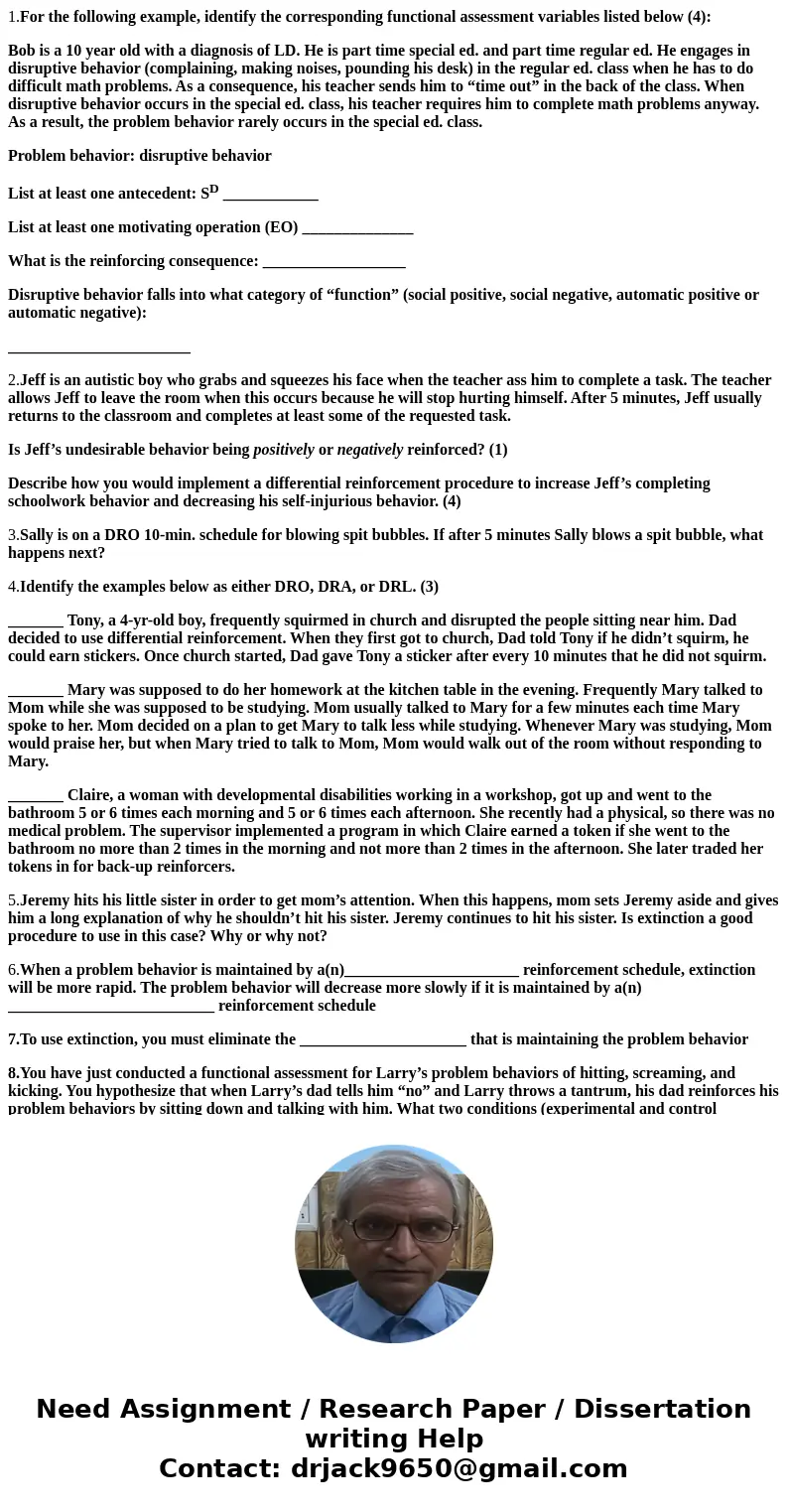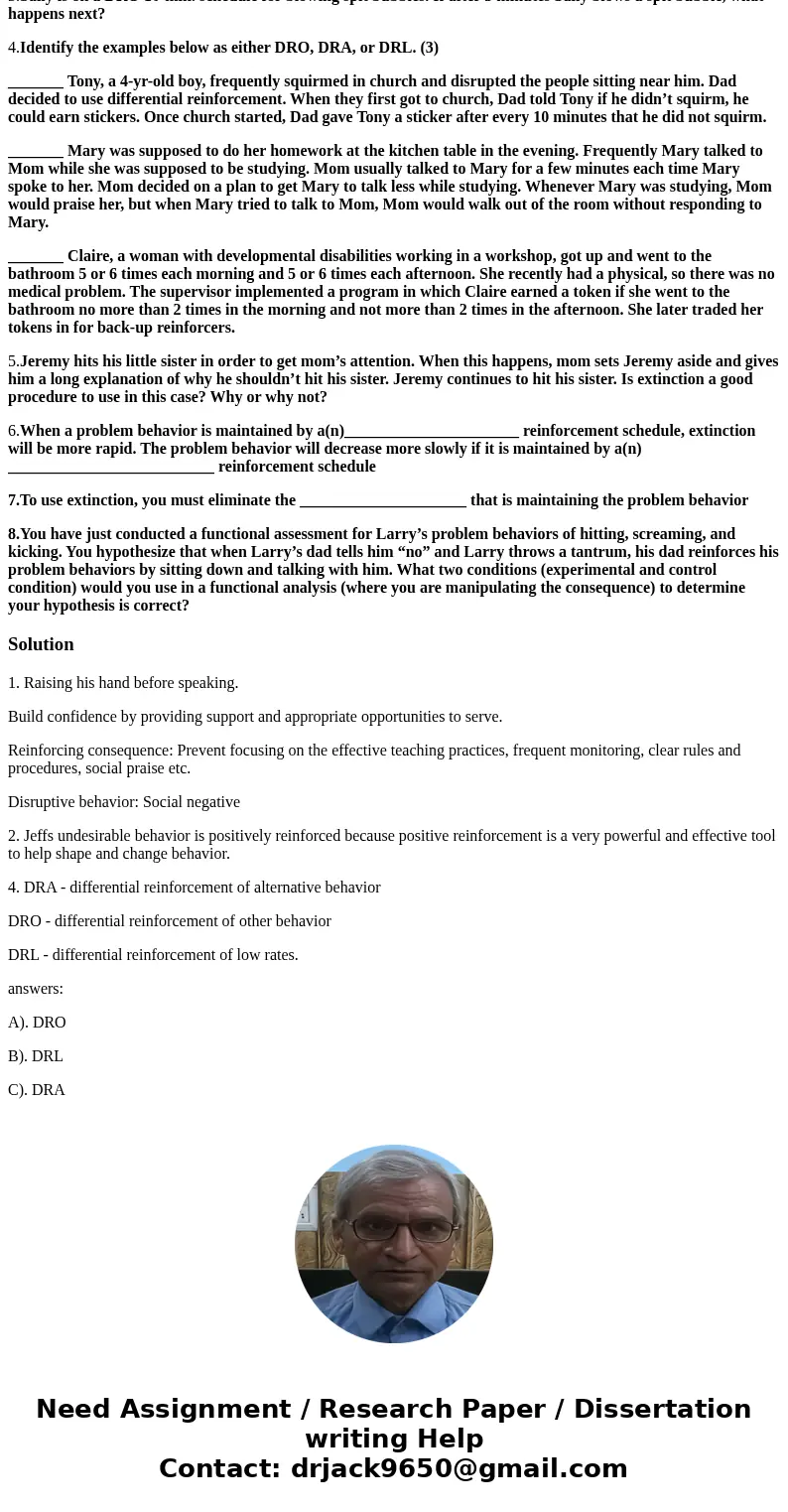1For the following example identify the corresponding functi
1.For the following example, identify the corresponding functional assessment variables listed below (4):
Bob is a 10 year old with a diagnosis of LD. He is part time special ed. and part time regular ed. He engages in disruptive behavior (complaining, making noises, pounding his desk) in the regular ed. class when he has to do difficult math problems. As a consequence, his teacher sends him to “time out” in the back of the class. When disruptive behavior occurs in the special ed. class, his teacher requires him to complete math problems anyway. As a result, the problem behavior rarely occurs in the special ed. class.
Problem behavior: disruptive behavior
List at least one antecedent: SD ____________
List at least one motivating operation (EO) ______________
What is the reinforcing consequence: __________________
Disruptive behavior falls into what category of “function” (social positive, social negative, automatic positive or automatic negative):
_______________________
2.Jeff is an autistic boy who grabs and squeezes his face when the teacher ass him to complete a task. The teacher allows Jeff to leave the room when this occurs because he will stop hurting himself. After 5 minutes, Jeff usually returns to the classroom and completes at least some of the requested task.
Is Jeff’s undesirable behavior being positively or negatively reinforced? (1)
Describe how you would implement a differential reinforcement procedure to increase Jeff’s completing schoolwork behavior and decreasing his self-injurious behavior. (4)
3.Sally is on a DRO 10-min. schedule for blowing spit bubbles. If after 5 minutes Sally blows a spit bubble, what happens next?
4.Identify the examples below as either DRO, DRA, or DRL. (3)
_______ Tony, a 4-yr-old boy, frequently squirmed in church and disrupted the people sitting near him. Dad decided to use differential reinforcement. When they first got to church, Dad told Tony if he didn’t squirm, he could earn stickers. Once church started, Dad gave Tony a sticker after every 10 minutes that he did not squirm.
_______ Mary was supposed to do her homework at the kitchen table in the evening. Frequently Mary talked to Mom while she was supposed to be studying. Mom usually talked to Mary for a few minutes each time Mary spoke to her. Mom decided on a plan to get Mary to talk less while studying. Whenever Mary was studying, Mom would praise her, but when Mary tried to talk to Mom, Mom would walk out of the room without responding to Mary.
_______ Claire, a woman with developmental disabilities working in a workshop, got up and went to the bathroom 5 or 6 times each morning and 5 or 6 times each afternoon. She recently had a physical, so there was no medical problem. The supervisor implemented a program in which Claire earned a token if she went to the bathroom no more than 2 times in the morning and not more than 2 times in the afternoon. She later traded her tokens in for back-up reinforcers.
5.Jeremy hits his little sister in order to get mom’s attention. When this happens, mom sets Jeremy aside and gives him a long explanation of why he shouldn’t hit his sister. Jeremy continues to hit his sister. Is extinction a good procedure to use in this case? Why or why not?
6.When a problem behavior is maintained by a(n)______________________ reinforcement schedule, extinction will be more rapid. The problem behavior will decrease more slowly if it is maintained by a(n) __________________________ reinforcement schedule
7.To use extinction, you must eliminate the _____________________ that is maintaining the problem behavior
8.You have just conducted a functional assessment for Larry’s problem behaviors of hitting, screaming, and kicking. You hypothesize that when Larry’s dad tells him “no” and Larry throws a tantrum, his dad reinforces his problem behaviors by sitting down and talking with him. What two conditions (experimental and control condition) would you use in a functional analysis (where you are manipulating the consequence) to determine your hypothesis is correct?
Solution
1. Raising his hand before speaking.
Build confidence by providing support and appropriate opportunities to serve.
Reinforcing consequence: Prevent focusing on the effective teaching practices, frequent monitoring, clear rules and procedures, social praise etc.
Disruptive behavior: Social negative
2. Jeffs undesirable behavior is positively reinforced because positive reinforcement is a very powerful and effective tool to help shape and change behavior.
4. DRA - differential reinforcement of alternative behavior
DRO - differential reinforcement of other behavior
DRL - differential reinforcement of low rates.
answers:
A). DRO
B). DRL
C). DRA


 Homework Sourse
Homework Sourse